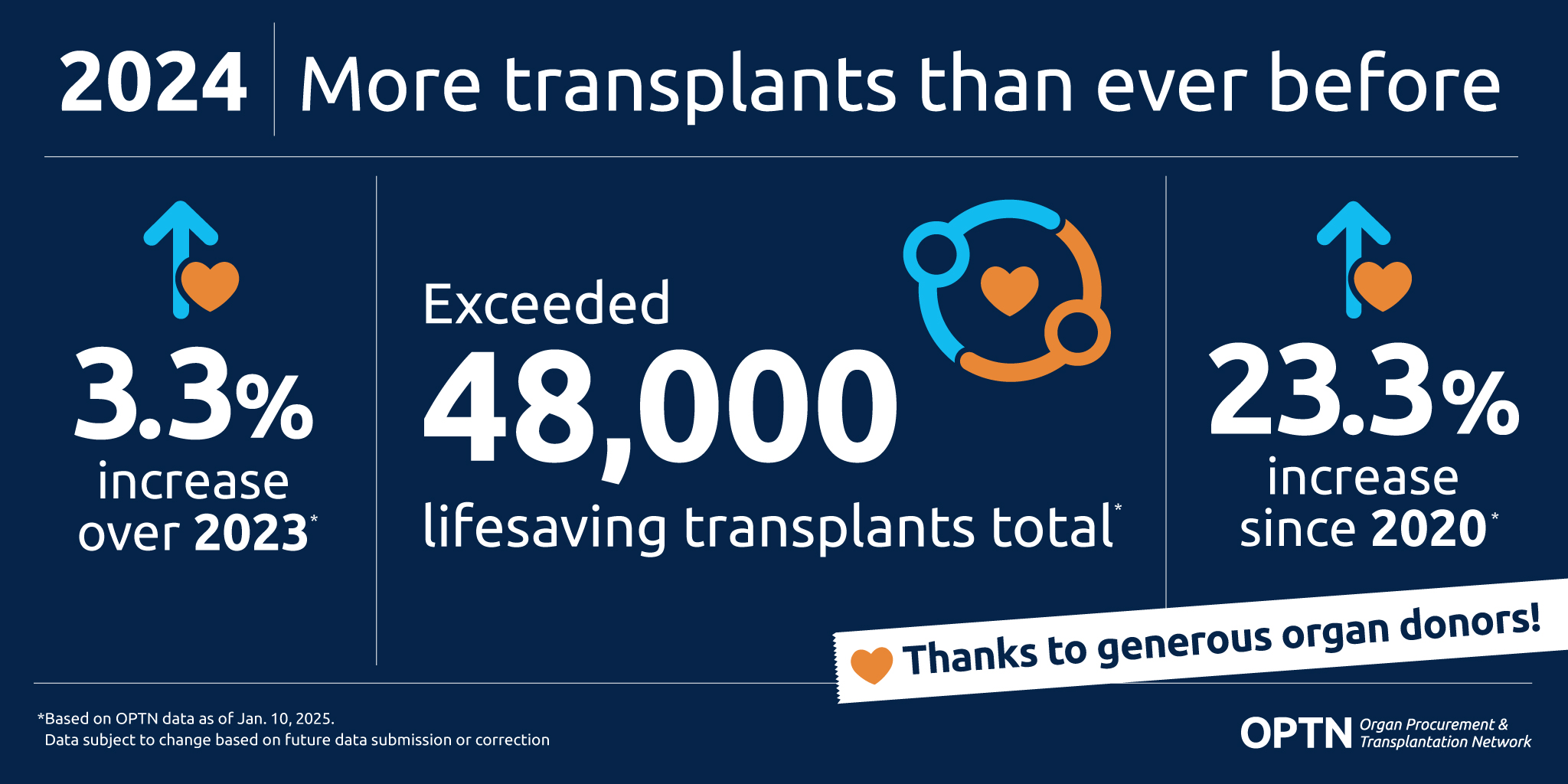Organ transplants exceeded 48,000 in 2024; a 3.3 percent increase from the transplants performed in 2023
Published on: Wednesday, January 15, 2025

More organ transplants occurred in the United States in 2024 than ever before, according to preliminary data from the Organ Procurement and Transplantation Network (OPTN).
The 48,149 transplants represent an increase of 3.3 percent compared to the 2023 total and 23.3 percent over the past five years. These life-saving procedures were made possible by the generous contributions of 16,988 deceased donors and 7,030 living donors.
“We are gratified that we are able to save and extend more lives each year through organ donation and transplantation,” said Richard Formica, M.D., president of the OPTN Board of Directors. “Yet many more people await the opportunity for a transplant. We must continue to grow and expand our capacity to ensure we are doing as many transplants as possible with the gifts entrusted to us.”
Transplant trends
A total of 41,119 transplants were made possible through deceased organ donation in 2024. This is the first year the threshold of 40,000 deceased donor transplants was surpassed, which represents an increase of 3.6 percent over 2023. Deceased donor transplants have set new annual records each of the past 12 years.
Living donors enabled an additional 7,030 transplants. This was the second highest annual total, surpassed only in 2019.
Lung transplants had the largest proportional growth from 2023 (3,026) to 2024 (3,340), an increase of 10.4 percent. Liver transplants had the next highest increase; the 11,458 procedures represent growth of 7.5 percent over 2023. A smaller increase occurred for kidney transplants (27,759 total, 1.6 percent over 2023). The number of heart transplants in 2024 (4,572) was virtually unchanged from the volume in 2023 (4,545).
Transplants continue to increase for transplant candidates from racial and ethnic minority groups, who represent a large proportion of the kidney transplant waiting list due to higher rates of kidney disease. The largest rate of increase over 2023 occurred for Hispanic/Latino recipients (9,097 in 2024, a 6.5 percent increase), followed by Black non-Hispanic recipients (10,990 in 2024, an increase of 1.5 percent).
While the ratios of transplant recipients by sex assigned at birth did not vary greatly for many organ types, liver transplants for female recipients increased notably; the 4,721 represented an increase of 12.4 percent over 2023. This may be attributable in part to a policy change enacted in July 2023 with a key goal of increasing equity in transplant access for adult female liver candidates.
Deceased donation trends
A total of 16,988 people were deceased donors in 2024, providing one or more organs for transplantation.
A major increase has occurred in donors who are pronounced dead after the total cessation of heartbeat and respiration (commonly called donation after circulatory death, or DCD). In particular, recent clinical practices have made it more clinically feasible for DCD organs to function well in lung and liver transplant recipients. In 2024, there were 7,280 DCD donors, an increase of 23.5 percent over 2023.
Conversely, the 9,706 donors who encountered brain death (total cessation of brain function) represented a decrease of seven percent compared to 2023. This is the first decrease in brain death donors since a steady rise began in 2013.
The proportion of deceased donors aged 50 and older continues to grow relative to donors of younger age. In 2024, there were 8,191 donors in this age range, accounting for 48.2 percent of the entire donor population.
In 2024, the number of donors who died from drug intoxication reversed an upward trend seen over several years, declining to 2,066, a 23.9 percent decrease compared to 2023 and the lowest annual total since 2021.
Living donor trends
A total of 7,030 people became living donors in 2024, donating either a whole kidney, a segment of their liver, or a uterus.
While the most common age range of living donors remains 35 to 49, there are increasing numbers of donors aged 50 and older.
Most notable is the increase in living donors aged 65 and older. In 2024, there were 476 such donors, an increase of 14.2 percent over 2023 and more than double the annual total each year up through 2016.



